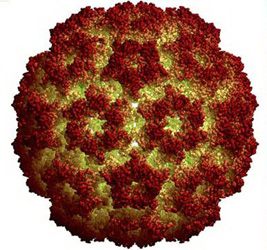

Develop spatial imagination
0.00 $
0 item(s)
Polyhedra in nature. Part 2
In the micro-world, polyhedra are found in molecules, viruses, and bacteria - the simplest organisms.
For example, fullerenes - spherical carbon molecules C60 (fig.) - "building blocks" of nanoelectronics and superconductors.

The hexagonal (hexagonal) structure is when the six water molecules (tetrahedra) are combined into a ring of all the various structures in nature. This type of structure is characteristic of ice, snow, and meltwater.



The exclusivity of the icosahedron was not accidental. It's all about saving - saving genetic information. You may ask: why is it necessarily the right polyhedron? And why exactly, icosahedron? The viral particle must turn the entire host cell metabolism upside down; it must force the infected cell to synthesize numerous enzymes and other molecules necessary to synthesize new virus particles. All of these enzymes must be encoded in viral nucleic acid. But its quantity is limited. Therefore, very little space is left to code its own membrane proteins in the virus nucleic acid. What does the virus do? It simply uses the same nucleic acid site many times to synthesize a large number of standard molecules — building proteins — that unite in the process of automating a virus particle.
The result is the maximum savings of genetic information.
Viruses solve by the most complicated task(it is called the "izopyrannoy"): finding the smallest surface body for a given volume and consisting of the same and the simplest figures. Viruses, the smallest of organisms, so simple that it is still not clear - refer them to living or inanimate nature - these same viruses have coped with the geometric problem that has required people for more than two thousand years! All the so-called "spherical viruses", including the poliovirus, are icosahedra, not a sphere, as previously thought.


Volvox algae - one of the simplest multicellular organisms - is a spherical shell, composed mainly of heptagonal, hexagonal, and pentagonal cells.


Three cells meet at each "vertex". Some instances have both quadrilateral and octagonal cells. Still, biologists have noticed that if there are no such "non-standard" cells (with less than five and more than seven), there are always twelve more pentagonal cells than heptagonal. There can be several hundred or even thousands of cells.
Popular
In the second half of the 19th century, a new teaching method was born in US schools - the project...
The festival of fascinating science was held in Moscow on April 24 and 25, 2015, at the physics...
The box geometric shape from a distance resembles a rounded shape, emphasizing the similarity with the...
Sometimes you hear the question: “Why did you choose paper (or more precisely, design cardboard) to...
Archimedes, a scientist from Ancient Greece, discovered thirteen types of polyhedra, now called...
The founders of Mirny, located in the Arkhangelsk region, placed a polyhedron, the Great...
The perfection of the spherical shape has long attracted thinkers and scientists who, using...

